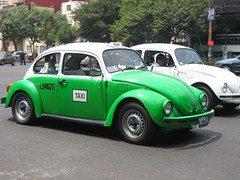
Many Mexico City cabbies still drive Volkswagen Beetles. The venerable cabs are gradually disappearing, however, as a city ordinance mandates that all newly-licensed taxis must have four doors.
Story by : David Agren
Martin Figueroa, a Mexico City cab driver, prowls the capital's Polanco and Zona Rosa districts in his green Volkswagen Beetle, searching for bargain-hunting passengers. On an average day the taxista (as Mexican cab drivers are known) makes 350 pesos, mostly by shuttling foreigners between their upscale hotels and the airport, although pirate taxis now pose unwelcome competition. He undercuts the prices charged by sitio taxis (vehicles assigned to stations that often use radios) because of his status as a libre (a taxi driver without a base) and his little green car, which due to regulations passed a few years ago in the Federal District, is set to go out of service within a decade.
The ubiquitous vocho (beetle) taxi, a long-time fixture on Mexico City streets, has fallen out of favor with many taxistas along with the capital's taxi regulator, which passed a regulation mandating that all new taxis must have four doors, leaving Volkswagen aficionados out of luck.
"Five years ago, it was almost 100 percent vochos," Figueroa comments, figuring that now only 30 percent of the approximately 120,000 Mexico City cabs are Volkswagens.
Nowadays taxistas mostly drive Nissan Tsurus and subcompact cars like the Hyundai Atos and tiny Chevys. The vocho stopped rolling off Volkswagen's Puebla assembly line in 2003, although the model is still fairly common on Mexican roads.
Figueroa works about 10 hours each weekday, driving a car that lacks power steering, air conditioning and a radio down the Federal Districts congested thoroughfares. As an independent operator, he makes a reasonable living. During an exceptional shift, he can earn up to 500 pesos, although, "You have to work all day to if you want to make (that)."
The taximeter in a Vocho starts at 5.60 pesos and climbs by 78 centavos every 250 meters. A ride in a newer libre taxi begins at 6.40 pesos. (Guadalajara taxi fares start at 7.74 pesos.) Sitio taxis, which often service hotels and office buildings, usually operate on a grid system, sometimes charging more than triple what a Vocho would.
Supposedly, the sitio taxis offer a more secure service, but Figueroa says licensed Vochos are usually safe too - despite their sketchy reputation.
"It's normal in a city so large that there would be problems," he comments. Both the U.S. State Department and Canadian government advise citizens not to hail taxis in Mexico City and to only climb into a cab associated with a reputable sitio. Stories of 24-hour kidnappings, where the victim is driven to a bank machine and forced to withdraw money, have become common. Virtually all vocho operators rip out their vehicles' front passenger seat, providing ample legroom for at least one occupant, but the unconventional exit route becomes a safety hazard - there's no easy escape in the event of a kidnapping.
All legal taxis, regardless of classification, sport license plates bearing the letter "L" for libre or "S" for sitio. The license number is also emblazoned across the roof and most drivers make their identifications easily available for inspection. Figueroa estimates 30,000 pirate cabs, which lack proper license plates, operate in Mexico City. Besides jeopardizing passenger safety, Figueroa says the pirate operators reduce profits for the legitimate drivers.
"There's a lot of competition," he explains.
"Unfortunately, it's reducing the number of available fares."
Still, Figueroa has no plans to give up his vocho until his taxi license expires in five years. Other Vocho drivers express similar sentiments.
Taxista Jose Antonio Castillo describes his Vocho as an "all-terrain" car.
He bought his Vocho for 70,000 pesos five years ago and insists, "It's still a good car ... it's really good on hills." The odometer has rolled over four times and now reads 419,527 kilometers.
Other taxistas show a little less affection for the vocho. Arturuo Rosas Vergara, a libre taxista, now drives a sub-compact Chevrolet painted red and white.
"It's more comfortable and uses less gasoline," he says.
As for getting behind the wheel of a vocho, he comments, "For a driver, driving it is tiring."


1 comment:
how to find a pretty vocho for sale ? la7ija@msn.com
Post a Comment